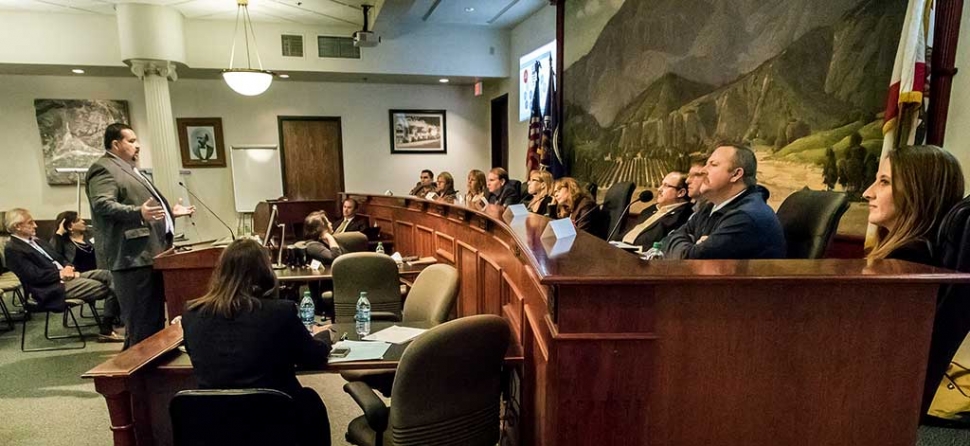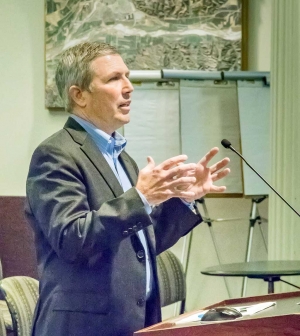|
Traffic, Water Treatment Plant and School District improvements discussed at Council
 City council meeting. Photos by Bob Crum. By Jean McLeod — Wednesday, March 9th, 2016
 Greg Ryan President of Pasteurization Technology Group gave a presentation on the new technology his company developed to save energy and more. Tuesday’s City Council meeting began with a Ventura County Transportation Commission Presentation and was followed by addressing some changes to the City's Aquatic Manual during the times that FUSD uses the pool, along with amending Fillmore's Municipal Code relating to curfews for minors during school hours. Other items discussed were the Do Not Sit On Wall signs placed on the planter in the center of Central Avenue and a report on the Humane Living Standards Residential Property Inspection Program. FUSD Superintendent Dr. Adrian Palazuelos addressed the Council and Trusties regarding the Long Range Facilities Master Plan. It’s a 10-year plan to upgrade and maintain the district's infrastructure. Palazuelos stated the importance of knowing "where to invest" and "what is actually possible," adding, "we want to do everything" but we must prioritize and identify what needs to be addressed first then define facility standards and question what should be fixed/repaired or replaced. "We need to make Sespe School up and running again" and that the current facilities need to be brought up to a high standard. He reminded everyone that the next Steering Committee Meeting will be held March 22, 2016 at 5:30 p.m. in the FUSD Board Room. Each Councilmember responded to Palazuelos' presentation with a thank you remarking on his great enthusiasm and thoughtful consideration of our schools and student's needs. Another District/City item dealt with was the use of the Aquatic Center. In 2009 an Aquatic Staff Orientation and Training Manual was adopted by the City Council and updated in 2014. In that manual it states "A minimum of two lifeguards will be scheduled (one deck guard/one in the guardroom).” Council and Trustees agreed that the wording be changed to read that during FUSD Swim Meets the District agrees to assume all responsibility and risk. A third item concerning the District was the City Ordinance dealing with Curfews for Minors. In 2014 the Council amended a Municipal Code removing language that required school age minors to be in school during the hours of 8:30 a.m. and 2:30 p.m. on school days. This was done to prevent youth who were home-schooled from being harassed. Palazuelos and Assistant Superintendent Stefan Cvijanovich who also represents the Human Resource and is Pupil Support Chairperson, FUSD School Attendance Review Board, wrote a letter to the Council asking that the wording be reinstated. The letter, read by Cvijanovich stated, "A daytime curfew ordinance which includes progressive consequences will enable us to work in partnership with law enforcement to ensure that all school-age students are in school." Ventura County Sheriff Leo Vasquez explained that truancy is an Educational Code violation and there is nothing law enforcement can do to address it. With returning the enforcement through the City's Municipal Code, the officers have the ability to take action on truancy. The Council agreed and reinstated the wording to include the curfew during school hours. Transportation and the need to improve Ventura County's roads were addressed in a presentation by Darren Kettle, Executive Director of Ventura County Transportation Commission (VCTC). Kettle informed the Council that the traffic in the County is getting worse, especially on two main corridors through the County; SR 118 and SR 101, with a projected 50% rise in traffic on Highway 101. He added in Ventura County there is a $3 billion shortfall in local identified needs over the next 30 years. With an aging population that is expected to double in 2030 the need for public transportation will increase, Kettle explained. State and federal funding is down which mostly comes from gas taxes and to offset the deficit as the federal government is reaching into the general fund. Kettle informed the Council that future transportation funds will be hit hard and proposes a half-cent sales tax increase to raise the $70 million a year needed. Over the next 30 years Kettle stated the cost to maintain and improve the County roads and transportation needs breaks down to: Local streets and roads $1.3 billion, Highways/Freeways $660 million, Ports/Military Base $290 million, Busses $240 million, Bicycle/Pedestrian $240 million, Environmental Preservation $240 million, Railroads $210 million. The goal of improving Freeways 101 and 118 alone is expected to cost $800 million. That expansion will add car pool and express lanes. Kettle said the goal of VCTC is to improve safety while keeping bus fares low and keeping buses and trains rolling. He informed the Board that four years ago the Fillmore City Engineer reported Fillmore had a $24 million shortfall in road and transportation funding. Today that amount is close to $36-$40 million. The need for a half-cent sales tax increase that Kettle suggests would have to be voted on in the 2016 election and require a two-thirds approval to pass. According to Kettle is would cost the average family the cost of a gallon on gas per week or an individual about one dollar per week. The issue of people loitering downtown on Central Avenue was once again up for discussion. Signs had been placed stating "Do Not Sit On the Wall" which, after a couple of days, were ignored. Discussions with the individuals who gather at the planter in front of the theatre, who were asked to gather at Central Park or the Active Adult Center, had failed and the loiterers let it be known they were staying where they wanted and would not move. Council Member Rick Neal stated, "I feel we should do something". Neal reminded everyone that the situation has been discussed more than once. Complaints of unacceptable conduct by those individuals who gather there continue, with little done to actually address it, stating, "It's not getting any better." Council Member Manuel Minjares responded, "I think it's a behavioral issue" and feels that peer pressure will stop the unacceptable behavior. Neal responded, "I don't think peer pressure is working." One of the big problems is the complaints of young girls being harassed as they pass by those who loiter in the area. Other complaints have come from shop owners and residents. Council Member Douglas Tucker responded, "We're talking about an ingrained behavior, it’s not that easy to fix. It's not an easy situation.” Minjares agreed the behavior is shameful. The Council agreed to put the problem on a future agenda and discuss a solution. Planning Department Kevin McSweeney gave the first of many reports on the Humane Living Standards Residential Property Inspection Program. In the past three months there have been 12 people who have signed up for the inspection process with one having pulled out. McSweeney will report back in three months on how the program has progressed. The program will sunset in 18 months if the results are not acceptable and not what was expected. Mayor Diane McCall questioned the amount of time city staff is spending on the program and felt the time could be better spent. A total of 27 hours in the three month period was used on the inspections. An item that is expected to save both the City and Fillmore residents’ energy is an improvement at the Fillmore Water Treatment Plant. Greg Ryan President of Pasteurization Technology Group gave a presentation on the new technology his company developed. The company has been in discussions with the City of Fillmore for a number of months on utilizing the new technology that uses a passive process of capturing heat which is reused to both generate power and sterilize water thus lowering the plants carbon footprint and saving operational costs. The upgrade will allow the plant to operate more hours and during any unforeseen power outage. Ryan states that over a 20-year use the average household will save $1,675 at a minimum. The Council agreed to start contract negotiations. |
